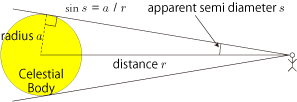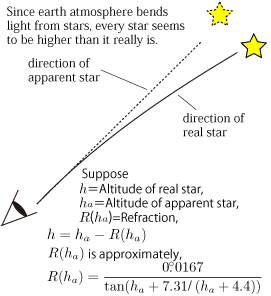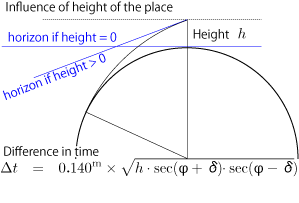Sunrise & Sunset
Sunrise and sunset are times when the upper limb of the Sun touches the horizon. The bending of light rays due to atmosphere, so called horizontal refraction (= 35' 8") is included.

Twilight (Yoake, Higure)
The sky is still illuminated before sunrise or after sunset. That's twilight.
Twilight starts (= yoake) and ends (= higure) when the altitude of the center of the Sun is equal to -7° 21' 40".
There are other similar concepts for twilight. Civil twilight starts and ends when outside activity is difficult without light. Nautical twilight starts and ends when it becomes too dark to see the horizon. Astronomical twilight starts and ends when you can see 6th magnitude stars with naked eyes. They are defined as the times when the altitude of the center of the Sun is equal to -6°, -12°, and -18°, respectively.
See "Twilight" (Japanese Only) for more information.
Rising & Setting of Moon and planets
Rising & Setting of the Moon are times when the center of the Moon touches the horizon. The reason we use the center of the Moon is that the upper limb of the Moon does not always shine due to waxing and waning. However, since the Moon is always full when the lunar eclipse occurs, we use the upper limb criteria in the local prediction of lunar eclipse.
Rising & Setting of the planets are times when the center of the planet touches the horizon.
The bending of light rays due to atmosphere, so called horizontal refraction (= 35' 8") is included. See "Days with no moonrise or moonset", "Rising / setting / meridian transit can occur twice a day" for more information.

Transit or Meridian Transit
Transit is the passage of center of the celestial body across the local meridian.

Altitude & Azimuth
Altitude is the angular distance of the celestial body above or below the horizon. Azimuth is the angular distance along the horizon measured clockwise from North, meaning azimuth of east is 90°.
We consider atmospheric refraction for the altitude.

Apparent Semi Diameter
Apparent Semi Diameter shows the apparent size of the celestial body.

Refraction
Since earth atmosphere bends light from stars, every star seems to be higher than it really is. This is called refraction.
Refraction depends on temperature, pressure, water vapor, wavelength of light, etc. and becomes larger as the altitude of the star becomes lower. See Chronological Scientific Tables or other textbooks for more details.

Influence of height of the place on times of rising and setting
If you are above the sea level, you can look down the horizon and see the Sun at lower altitude. Because of this, sunrise gets early and sunset gets late.
But when the whole place around the observer is equally high, the direction of horizon does not change and influence of height is not effective. So we usually set height to be zero.
